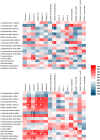In-and-Out Molecular Changes Linked to the Type 2 Diabetes Remission after Bariatric Surgery: An Influence of Gut Microbes on Mitochondria Metabolism
- PMID: 30477251
- PMCID: PMC6321270
- DOI: 10.3390/ijms19123744
In-and-Out Molecular Changes Linked to the Type 2 Diabetes Remission after Bariatric Surgery: An Influence of Gut Microbes on Mitochondria Metabolism
Abstract
Different kinds of gastrointestinal tract modulations known as "bariatric surgery" are actually the most effective treatment for obesity and associated co-morbidities, such as type 2 diabetes (T2DM). The potential causes of those effects have yet to be explained. In our study, we focused on molecular changes evoked by laparoscopic sleeve gastrectomy leading to T2DM remission. Two complementary metabolomics techniques, namely, liquid chromatography coupled with mass spectrometry (LC-MS) and gas chromatography mass spectrometry (GC-MS), were used to study those effects in a group of 20 obese patients with T2DM selected from a cohort of 372 obese individuals who underwent bariatric surgery and did not receive anti-diabetic treatment afterward. Modified levels of carnitines, lipids, amino acids (including BCAA) and α- and β-hydroxybutyric acids were detected. Presented alterations suggest a major role of mitochondria activity in T2DM remission process. Moreover, some of the observed metabolites suggest that changes in gut microbiota composition may also correlate with the tempo of diabetes recovery. Additional analyses confirmed a relationship between biochemical and clinical parameters and the aforementioned metabolites, thereby, highlighting a role of mitochondria and microbes. Our data suggests that there is a previously undescribed relationship between mitochondria and gut microbiota, which changes after the bariatric surgery. More investigations are needed to confirm and explore the observed findings.
Keywords: GC-MS; LC-MS; bariatric surgery; diabetes remission; laparoscopic sleeve gastrectomy; metabolomics.
Conflict of interest statement
The authors declare no conflict of interest.
Figures




Similar articles
-
The Potential Mechanism of Remission in Type 2 Diabetes Mellitus After Vertical Sleeve Gastrectomy.Obes Surg. 2024 Aug;34(8):3071-3083. doi: 10.1007/s11695-024-07378-z. Epub 2024 Jul 1. Obes Surg. 2024. PMID: 38951388 Review.
-
Remission of Type 2 Diabetes Mellitus in Patients After Different Types of Bariatric Surgery: A Population-Based Cohort Study in the United Kingdom.JAMA Surg. 2015 Dec;150(12):1126-33. doi: 10.1001/jamasurg.2015.2398. JAMA Surg. 2015. PMID: 26422580
-
"Gear mechanism" of bariatric interventions revealed by untargeted metabolomics.J Pharm Biomed Anal. 2018 Mar 20;151:219-226. doi: 10.1016/j.jpba.2018.01.016. Epub 2018 Jan 9. J Pharm Biomed Anal. 2018. PMID: 29413971
-
Differential Changes in Gut Microbiota After Gastric Bypass and Sleeve Gastrectomy Bariatric Surgery Vary According to Diabetes Remission.Obes Surg. 2017 Apr;27(4):917-925. doi: 10.1007/s11695-016-2399-2. Obes Surg. 2017. PMID: 27738970 Clinical Trial.
-
Gut Microbiota Dysbiosis in Human Obesity: Impact of Bariatric Surgery.Curr Obes Rep. 2019 Sep;8(3):229-242. doi: 10.1007/s13679-019-00351-3. Curr Obes Rep. 2019. PMID: 31197613 Review.
Cited by
-
CircRNA PLOD2 enhances ovarian cancer propagation by controlling miR-378.Saudi J Biol Sci. 2021 Nov;28(11):6260-6265. doi: 10.1016/j.sjbs.2021.06.088. Epub 2021 Jul 3. Saudi J Biol Sci. 2021. PMID: 34759745 Free PMC article.
-
Analysis of correlations between gut microbiota, stool short chain fatty acids, calprotectin and cardiometabolic risk factors in postmenopausal women with obesity: a cross-sectional study.J Transl Med. 2022 Dec 12;20(1):585. doi: 10.1186/s12967-022-03801-0. J Transl Med. 2022. PMID: 36503483 Free PMC article.
-
Effect of Bariatric Surgery on Metabolic Diseases and Underlying Mechanisms.Biomolecules. 2021 Oct 26;11(11):1582. doi: 10.3390/biom11111582. Biomolecules. 2021. PMID: 34827579 Free PMC article. Review.
-
The Potential Mechanism of Remission in Type 2 Diabetes Mellitus After Vertical Sleeve Gastrectomy.Obes Surg. 2024 Aug;34(8):3071-3083. doi: 10.1007/s11695-024-07378-z. Epub 2024 Jul 1. Obes Surg. 2024. PMID: 38951388 Review.
-
An Integrated Fecal Microbiome and Metabolomics in T2DM Rats Reveal Antidiabetes Effects from Host-Microbial Metabolic Axis of EtOAc Extract from Sophora flavescens.Oxid Med Cell Longev. 2020 May 27;2020:1805418. doi: 10.1155/2020/1805418. eCollection 2020. Oxid Med Cell Longev. 2020. PMID: 32566075 Free PMC article.
References
-
- Lee W.-J., Almalki O. Mechanism of diabetes control after metabolic surgery. Ann. Laparosc. Endosc. Surg. 2017;2:128. doi: 10.21037/ales.2017.07.05. - DOI
MeSH terms
Substances
Grants and funding
LinkOut - more resources
Full Text Sources
Medical
Miscellaneous

